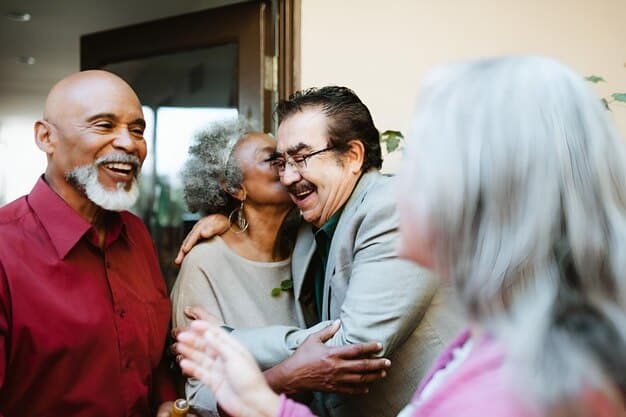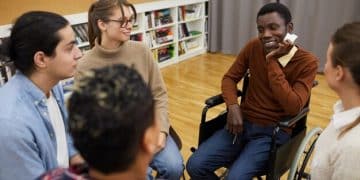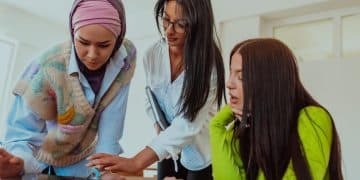Combating Ageism, Fostering Intergenerational Understanding

Combating ageism and promoting intergenerational understanding necessitates a multi-faceted approach, encompassing education, policy reform, media representation, and fostering genuine opportunities for interaction and collaboration across age groups to dismantle stereotypes and build empathy.
The concept of ageism, often subtle yet deeply ingrained, permeates many aspects of modern society, frequently undervaluing wisdom while overemphasizing youth. Understanding How Can We Combat Ageism and Promote Intergenerational Understanding? is not merely an academic exercise but a societal imperative, crucial for fostering inclusive communities where individuals of all ages can thrive and contribute meaningfully. By delving into the roots of entrenched biases and exploring effective strategies, we can begin to reshape perceptions and build a more cohesive future.
Understanding the Roots of Ageism
The origins of ageism are complex, often rooted in societal shifts, economic pressures, and cultural narratives that prioritize productivity and youth. This bias can manifest in various forms, from overt discrimination in the workplace to subtle assumptions about capabilities and interests based solely on age. Recognizing these underlying factors is the first step toward dismantling ageist attitudes and creating a more equitable landscape for everyone.
Ageist stereotypes, for instance, frequently paint older adults as technologically inept, resistant to change, or frail, while younger generations are sometimes dismissed as inexperienced, entitled, or lacking in commitment. These broad generalizations prevent individuals from seeing each other’s unique strengths and instead perpetuate harmful divisions. The media, too, often plays a role, inadvertently reinforcing these stereotypes through limited or one-dimensional portrayals of different age groups. Tackling ageism requires a critical examination of these pervasive narratives and a commitment to challenging them wherever they arise.
Historical and Societal Factors
Throughout history, the social standing of different age groups has fluctuated, often reflecting economic conditions and prevailing cultural values. Industrialization, for example, reshaped societal structures, emphasizing efficiency and economic output, which sometimes marginalized those perceived as less productive, including older individuals. In contemporary society, a fast-paced, technologically driven environment can inadvertently amplify age-related biases, particularly concerning digital literacy and adaptability.
It’s important to recognize that ageism isn’t just about individual prejudice; it’s often systematized. Policies in employment, healthcare, and education can unintentionally embed ageist practices, creating barriers that limit opportunities and access for certain age groups. For example, mandatory retirement ages, while sometimes having historical justifications, can now be seen as an arbitrary limit on an individual’s professional contribution, irrespective of their capabilities or desire to work.
- The emphasis on a “youth-driven” culture in advertising and entertainment often sidelines older perspectives.
- Rapid technological advancements can create a perceived “digital divide,” fostering stereotypes about tech-savviness.
- Economic competition sometimes leads to assumptions about the cost-effectiveness or adaptability of older workers.
The Impact of Language and Media
The language we use and the way media portrays age groups significantly shape public perception. Terms like “senior moment,” “boomer,” or “snowflake” can be dismissive, reducing complex individuals to oversimplified caricatures. News stories might focus disproportionately on the challenges of aging without highlighting the resilience, wisdom, and contributions of older adults. Similarly, younger generations might be stereotyped as self-absorbed or lacking resilience, ignoring their activism and innovation.
Media representation, whether in films, television, or advertising, often perpetuates these narrow views. If older individuals are consistently shown as frail or dependent, and younger people as reckless or naive, these images become entrenched in the collective consciousness. To truly combat ageism, a conscious effort is needed to diversify these narratives, portraying individuals of all ages as dynamic, capable, and multifaceted. This shift in portrayal can inspire a more nuanced understanding and appreciation across the age spectrum.
The language employed in everyday conversations often unconsciously reinforces ageist assumptions. Phrases that infantilize older adults or dismiss the experiences of younger people contribute to a culture where age rather than individual merit is the primary determinant of respect or consideration. Such linguistic patterns need to be challenged, as they normalize prejudices that lead to discrimination. Creating a more inclusive dialogue involves being mindful of the words chosen, ensuring they reflect respect for people at every stage of life.
The widespread use of social media and online platforms also presents a double-edged sword. While they can amplify diverse voices and foster intergenerational connections, they also offer fertile ground for the rapid spread of ageist memes and jokes, which can trivialize the issue or normalize discriminatory attitudes. Promoting digital literacy and critical consumption of online content is thus an integral part of combating ageism in the modern era.
In conclusion, ageism is not a superficial issue but a deeply embedded societal problem influenced by historical contexts, economic structures, popular culture, and language. Addressing it requires a fundamental shift in how we perceive and interact with different age groups, demanding a conscious effort to challenge stereotypes and promote accurate, respectful representation. Only by understanding these roots can we effectively dismantle ageist practices and foster a truly intergenerational society.
Strategies for Educational and Awareness Programs
Education and awareness are fundamental pillars in the fight against ageism and in promoting intergenerational understanding. Knowledge empowers individuals to identify and challenge biases, both within themselves and in society. Programs designed to raise awareness can target various age groups, from young children to older adults, fostering empathy and dismantling preconceived notions from an early age.
Effective educational initiatives move beyond simply stating facts; they often incorporate interactive elements, personal storytelling, and collaborative activities that allow participants to experience different perspectives. These programs can be integrated into school curricula, workplace training, community outreach, and public media campaigns, ensuring a broad reach and continuous reinforcement of inclusive values. The goal is to nurture a culture where age is celebrated for its diversity rather than being a source of division.
Promoting Age-Inclusive Curricula in Schools
Introducing age-inclusive concepts in schools can lay the groundwork for a more age-friendly society. Curricula can incorporate topics that highlight the contributions of people of all ages, discuss the history and impact of ageism, and encourage students to think critically about stereotypes. Storytelling, role-playing, and projects that involve interactions with different generations can make these lessons tangible and impactful.
By normalizing discussions about age diversity, schools can help children develop a broader understanding of human development and appreciate the value of diverse life experiences. This proactive approach can prevent ageist biases from taking root, fostering a generation that is naturally more empathetic and inclusive. Engaging students in community service projects with older adults, for example, can create meaningful connections and break down barriers organically.
- Develop educational materials that accurately represent diverse aging experiences.
- Implement classroom projects that encourage intergenerational dialogue and collaboration.
- Host school events that bring together students and older community members for shared activities.
Workplace Training and Policy Development
Workplaces are critical arenas for combating ageism, as discrimination can significantly impact careers and economic well-being. Training programs can educate employees and managers about unconscious biases related to age, teaching them to recognize and address ageist assumptions in hiring, promotion, and team dynamics. These programs should emphasize the benefits of age diversity, such as a wider range of skills, perspectives, and experiences that can boost innovation and problem-solving.
Beyond training, companies must develop and enforce robust anti-ageism policies. This includes reviewing recruitment practices to ensure they are age-neutral, implementing flexible work arrangements that benefit employees of all generations, and creating mentorship programs that encourage knowledge transfer across age groups. A truly age-inclusive workplace values every employee’s contribution, fostering an environment where talent and experience, not age, determine opportunity.
Such training should focus on practical strategies, such as blind resume reviews to mitigate age bias in initial screening, and structured interview processes that focus solely on qualifications and experience. Policies promoting continuous learning and development for all employees, regardless of age, ensure that skills remain current and opportunities for growth are available to everyone. Addressing ageism in the workplace goes beyond compliance; it’s about cultivating a truly diverse and productive environment.
Furthermore, fostering a culture of reverse mentorship, where younger employees mentor older ones on new technologies and trends, and vice-versa, can create a powerful dynamic of mutual respect and learning. This not only bridges knowledge gaps but also reinforces the idea that wisdom and expertise flow in multiple directions, challenging traditional hierarchies based on age. Companies that embrace these strategies often find themselves with more resilient, innovative, and loyal workforces.
Ultimately, educational and awareness programs are powerful tools in shaping individual attitudes and societal norms. By consistently challenging ageist stereotypes and promoting inclusive perspectives, these initiatives can cultivate a deeper respect for people of all ages. This foundational work is essential for building communities where age is seen as a source of richness and diversity, rather than a category for division or prejudice.
Fostering Intergenerational Connection and Collaboration
One of the most effective ways to combat ageism and promote understanding is through direct intergenerational connection and collaboration. When individuals from different age groups share experiences, work together on common goals, and learn from one another, stereotypes begin to dissolve, replaced by genuine empathy and respect. These interactions move beyond superficial judgments, allowing people to see each other as unique individuals with valuable insights and perspectives.
Creating intentional spaces and opportunities for these connections is crucial. This can range from structured programs in communities and schools to more informal gatherings that naturally bring diverse age groups together. The shared experiences built through these interactions are far more impactful than abstract discussions about ageism, fostering a lived understanding that transcends biases.

Community Initiatives and Programs
Many communities are recognizing the power of intergenerational programs to strengthen social bonds and address specific needs. These initiatives can include shared housing programs where older adults offer affordable living spaces to younger people in exchange for companionship or assistance, or community gardens where different age groups work side-by-side to grow food. Such programs often create natural opportunities for conversation, mentorship, and mutual support.
Libraries, community centers, and faith-based organizations are excellent venues for hosting these initiatives. Workshops where older adults teach traditional skills (e.g., knitting, carpentry) and younger people share digital knowledge (e.g., social media, coding) are prime examples of mutually beneficial exchanges. These activities highlight the unique strengths and contributions of each generation, fostering mutual appreciation and shared purpose.
The design of public spaces can also play a role in fostering intergenerational connections. Parks with playgrounds for children and accessible walking paths for older adults, or community centers with diverse programming for all ages, can inadvertently create opportunities for different generations to cross paths and interact. Thoughtful urban planning considers the needs and opportunities for connection across the age spectrum.
Mentorship and Reverse Mentorship
Mentorship has long been recognized as a valuable tool for professional and personal development, and it holds immense potential for bridging generational divides. Traditional mentorship, where experienced older individuals guide younger ones, offers a rich transfer of knowledge, wisdom, and professional networks. The younger protégé gains insights into career paths and challenges, benefiting from years of accumulated experience.
However, “reverse mentorship” is equally powerful. In this dynamic, younger individuals share their expertise, particularly in areas like technology, social media, or emerging trends, with older colleagues or community members. This role reversal challenges traditional hierarchies, empowering younger voices and demonstrating that valuable knowledge flows in multiple directions. It fosters a reciprocal learning environment where both parties feel valued and contribute unique skills.
- Traditional Mentorship: Provides career guidance, industry insights, and life lessons from experienced elders to younger generations.
- Reverse Mentorship: Enables younger individuals to share digital literacy, modern communication tools, and fresh perspectives with older counterparts.
- Peer Mentorship: Facilitates learning and support between individuals within similar age ranges but different experience levels, or across narrowly defined generational gaps.
Both forms of mentorship cultivate respect and a deeper understanding of differing perspectives, skills, and values across generations. They underscore the idea that everyone has something valuable to teach and something new to learn, regardless of their age. By formalizing or informally encouraging these relationships, organizations and communities can naturally breakdown ageist barriers.
In essence, fostering intergenerational connection and collaboration is about creating authentic opportunities for people to interact as individuals, rather than as representatives of their age groups. These shared experiences build bridges of understanding, dismantle stereotypes, and pave the way for a more cohesive, empathetic, and age-inclusive society where the unique contributions of every generation are recognized and celebrated.
The Role of Media and Cultural Representation
The media holds immense power in shaping societal perceptions, and its role in either perpetuating or dismantling ageism cannot be overstated. From the types of characters portrayed in television and film to the language used in news reporting and advertising, cultural representation sends powerful messages about the value and capabilities of different age groups. To truly combat ageism, conscious efforts must be made to diversify and accurately represent the full spectrum of human experience across the lifespan.
Negative or one-dimensional portrayals reinforce stereotypes, while positive and multifaceted representations can foster empathy and understanding. A deliberate shift in media narratives is essential for changing public attitudes and challenging deeply ingrained biases that often go unnoticed. This involves not only showcasing diverse older and younger individuals but also depicting rich, complex intergenerational relationships.
Challenging Stereotypes in Entertainment and Advertising
Entertainment media, including films, television shows, and streaming content, often falls into the trap of depicting older adults as frail, senile, or eccentric, and younger individuals as naive, irresponsible, or obsessed with fleeting trends. This lack of nuanced portrayal limits public understanding and perpetuates harmful ageist stereotypes. There is a pressing need for more complex, diverse characters of all ages who reflect the reality of modern life—individuals who are vibrant, active, contributing members of society, regardless of their chronological age.
Similarly, advertising frequently targets specific age demographics with narrow, stereotypical messages. Older adults might be shown primarily in ads for health products or retirement services, while younger people are used to sell consumer goods related to fleeting trends. Brands have an opportunity, and perhaps a responsibility, to create campaigns that defy these stereotypes, featuring intergenerational interactions and showcasing individuals of all ages engaged in diverse activities that resonate with broader audiences.
Challenging these stereotypes requires creators and advertisers to engage in critical self-reflection. Are they unwittingly contributing to ageist narratives? Can they imagine and depict stories that show meaningful intergenerational friendships, collaborative work environments, or older adults embracing new technologies? By doing so, they not only offer a more accurate reflection of society but also help normalize and celebrate age diversity.
Promoting Diverse and Authentic Narratives
Moving beyond stereotypes means actively seeking out and promoting narratives that highlight the richness and complexity of aging and youth. This includes showcasing diverse experiences within age groups—recognizing that not all older adults are the same, just as not all young people fit into a single mold. Authentic storytelling can reveal the unique challenges, triumphs, and perspectives associated with different life stages, thereby building a bridge of empathy across generations.
News media also has a critical role to play. Instead of focusing solely on problems associated with aging or the perceived deficits of younger generations, reporters can highlight intergenerational success stories, collaborative projects, and the unique contributions of individuals from every age group. By shifting the spotlight, media can reframe the public discourse around age, fostering a more positive and inclusive understanding.
The rise of independent media, podcasts, and social media offers new avenues for diverse voices to challenge traditional narratives. Individuals and community groups can create their own content, sharing personal stories that counteract mainstream stereotypes and offer more authentic glimpses into intergenerational life. This bottom-up approach to content creation can be a powerful force for change, reflecting lived realities that resonate with broader audiences.
In summary, the media’s influence on cultural perceptions of age is profound. By intentionally breaking away from traditional, often ageist, portrayals in entertainment, advertising, and news, and by actively promoting diverse and authentic narratives, society can begin to dismantle deeply ingrained biases. This conscious shift in representation is vital for fostering environments where people of all ages are seen and valued for their full potential, contributing to a more respectful and interconnected global community.
Policy and Legislative Approaches to Combat Ageism
While cultural shifts and educational programs are vital, concrete policy and legislative actions provide the structural framework needed to combat ageism systematically. Laws and regulations can prevent discrimination, promote equitable opportunities, and ensure that individuals of all ages are treated fairly in critical areas like employment, healthcare, and public services. Without robust policy frameworks, individual biases can easily translate into systemic disadvantages.
Effective policy aims to create a level playing field, challenging practices that inadvertently or intentionally disadvantage certain age groups. This involves not only prohibiting discrimination but also actively promoting age-inclusive practices that benefit society as a whole. A legislative approach signals a societal commitment to valuing every member, regardless of their age.
Anti-Discrimination Laws and Enforcement
Anti-discrimination laws are the cornerstone of any effort to combat ageism. In many countries, legislation already exists to protect against age discrimination in employment, but the scope and enforcement of these laws can vary significantly. Strengthening these laws to cover more areas, such as access to goods and services, housing, and financial products, is crucial. Moreover, effective enforcement mechanisms are necessary to ensure that these laws are not merely symbolic but provide tangible protection.
Beyond legal frameworks, there is a need for proactive measures by regulatory bodies. This could involve regular audits of hiring practices in businesses, investigating complaints of age discrimination more thoroughly, and imposing significant penalties on organizations that fail to comply. Raising awareness among the public about their rights under these laws is also essential, empowering individuals to challenge discriminatory practices when they encounter them.
Promoting Age-Friendly Environments and Services
Creating “age-friendly” environments and services involves designing cities, communities, and public amenities that are accessible and welcoming to people of all ages. This includes flexible public transportation options, pedestrian-friendly infrastructure, accessible public buildings, and green spaces that accommodate diverse activity levels. Age-friendly policies recognize that a society that works well for its oldest and youngest members works better for everyone else too.
Policy initiatives can also focus on adapting public services. Healthcare systems, for example, can implement training for medical professionals to avoid ageist assumptions in diagnosis and treatment. Financial institutions can offer tailored literacy programs for different age groups, recognizing varying needs and circumstances. These policies aim to remove barriers and ensure that everyone can participate fully in civic and economic life.
- Invest in accessible infrastructure like ramps, wide sidewalks, and public seating.
- Develop public transportation systems that cater to varying mobility levels and schedules.
- Incentivize businesses to adopt age-inclusive hiring and customer service practices.
Beyond specific legislative acts, policies can also encourage systemic shifts. For example, governments can fund pilot programs for intergenerational living arrangements or offer grants for community centers that prioritize age-inclusive programming. These broader policy approaches demonstrate a commitment to fostering a society where age is seen as a source of diversity and strength, rather than a basis for division.
In conclusion, policy and legislative approaches are critical for embedding anti-ageist principles into the fabric of society. By establishing legal protections, promoting inclusive practices, and creating age-friendly environments, these measures translate the aspiration of intergenerational understanding into concrete, enforceable actions. This structural support is indispensable for building communities where individuals of all ages are respected, valued, and empowered to contribute fully.
Individual Actions and Personal Responsibility
While systemic changes through policy and broad awareness campaigns are crucial, the fight against ageism and the promotion of intergenerational understanding ultimately depend on individual actions and personal responsibility. Each person has the power to challenge their own biases, engage with others across the age spectrum, and contribute to a more inclusive culture in their daily interactions. Authentic change often begins at the personal level, spreading outwards to families, workplaces, and communities.
Taking personal responsibility means actively reflecting on one’s own assumptions about age and consciously seeking out opportunities to learn from and connect with people who are older or younger. It involves listening with an open mind, challenging casual ageist remarks, and embracing the richness that diverse life experiences bring to any interaction.
Challenging Personal Biases and Assumptions
The first step in taking personal responsibility is to acknowledge that everyone, to some extent, may harbor unconscious biases related to age. These biases are often absorbed from societal messages, media portrayals, and limited personal experience. Challenging them requires introspection and a willingness to confront uncomfortable truths. Are you quicker to dismiss someone’s opinion based on their age? Do you unintentionally use infantilizing language with older adults or condescending tones with younger ones?
Active self-correction is key. When you catch yourself making an age-based assumption, pause and question its validity. Seek out information that challenges your preconceived notions. For instance, read articles or books written by authors of different generations, or intentionally follow social media accounts that showcase diverse age experiences. Over time, this conscious effort can rewire biases and foster a more open, equitable mindset.
Engaging in Intergenerational Dialogue
Simply interacting with people of different ages is one of the most powerful ways to break down barriers. Initiate conversations with neighbors, colleagues, or family members who are significantly older or younger than you. Ask them about their experiences, their perspectives on current events, or their life advice. Listen actively, without judgment or the urge to impose your own views. These genuine dialogues build bridges of understanding and reveal shared humanity.
Participation in intergenerational activities, whether organized through a community center or informal social gatherings, can also be transformative. Shared hobbies, volunteer work, or even just regular social events can create natural opportunities for meaningful connection. The more diverse your social circle, the more likely you are to challenge your own biases and appreciate the unique contributions of every age group.

Beyond casual interactions, consider seeking out opportunities for more structured intergenerational connections. Offer to mentor a younger person in your field, or ask an older adult to share their wisdom on a topic where they have deep experience. These mutually beneficial exchanges reinforce the idea that everyone has valuable insights to offer, regardless of their age.
Cultivating a personal commitment to combating ageism means actively being an ally. Speak up if you hear ageist jokes or comments. Advocate for age-inclusive practices in your workplace or community. Your personal voice and actions, however small they may seem, contribute to a larger cultural shift.
Ultimately, individual actions are the threads that weave the fabric of an age-inclusive society. By challenging our own biases, engaging in genuine intergenerational dialogue, and taking responsibility for our interactions, we contribute to a cultural environment where age is celebrated for its diversity, and everyone feels valued and respected for their unique contributions. This personal commitment is foundational to building truly intergenerational communities.
Innovations and Future Directions
The landscape of ageism and intergenerational understanding is constantly evolving, requiring innovative approaches and forward-thinking strategies. As societies confront demographic shifts, technological advancements, and changing social norms, new opportunities arise for fostering greater connection and challenging long-held biases. Looking ahead, the focus must be on scalable solutions, leveraging technology, and integrating age-friendly principles into diverse sectors of society.
Future directions involve not just addressing current challenges but proactively designing systems and cultures that inherently promote intergenerational respect and collaboration. This requires creativity, collaboration across disciplines, and a willingness to adapt traditional models to meet contemporary needs.
Technological Solutions for Bridging Divides
Technology, often perceived as a source of generational division, holds immense potential for bridging divides when applied thoughtfully. Digital platforms can facilitate intergenerational communication, shared learning, and collaborative projects, regardless of geographic barriers. Initiatives that teach digital literacy across age groups can empower older adults, connecting them to younger generations and expanding their access to information and services.
Beyond communication, technology can also enable virtual mentorship programs, online communities centered on intergenerational hobbies, or even gaming platforms designed to bring different age groups together. Gamified learning about ageism, for example, could offer an engaging way to educate younger generations. The key is to design technology that is inclusive, intuitive, and fosters genuine human connection, rather than isolation.
Future Research and Policy Integration
Continued research is essential to deepen our understanding of ageism, its nuances, and its evolving manifestations. This includes studies on the psychological impacts of ageism, its economic costs, and the most effective interventions across different cultural contexts. Longitudinal studies following cohorts of individuals across decades can provide invaluable insights into how perceptions of age evolve over a lifetime.
The findings from this research must then be effectively translated into policy. This means not only updating existing laws but also integrating age-friendly principles into urban planning, public health initiatives, educational systems, and economic development strategies. Proactive policy integration ensures that as societies develop, they do so in a way that inherently values and includes all age groups from the outset.
The integration of age-friendly principles into smart city development, for example, can involve designing public spaces and services with universal accessibility in mind, ensuring they cater to diverse mobility and cognitive needs. Similarly, future educational frameworks could embed intergenerational learning as a core component, preparing future generations for a world where collaboration across ages is the norm.
Furthermore, exploring the potential of AI and big data in identifying and mitigating ageist patterns in systems, such as in hiring algorithms or healthcare protocols, represents another frontier. While acknowledging ethical considerations, these technologies could offer valuable tools for uncovering subtle biases and promoting more equitable outcomes for all ages.
In conclusion, the future of combating ageism lies in a combination of sustained effort, innovative thinking, and proactive planning. By leveraging technology responsibly, investing in ongoing research, and integrating age-friendly principles into the very fabric of society, we can move beyond simply addressing ageism to building truly intergenerational communities where every individual is valued and has the opportunity to thrive throughout their lives.
| Key Principle | Brief Description |
|---|---|
| 📚 Education | Challenge ageist stereotypes through inclusive curricula and awareness programs. |
| 🤝 Connection | Foster intergenerational interactions and mentorship through community initiatives. |
| ⚖️ Policy | Implement and enforce anti-discrimination laws and age-friendly policies. |
| 🧠 Personal Action | Individuals must challenge biases and engage in open dialogue across generations. |
Frequently Asked Questions About Ageism and Intergenerational Understanding
Ageism is discrimination and stereotyping based on age. It can affect any age group but primarily impacts older and younger people. It manifests in various forms, including prejudice in media representation, discrimination in employment, and assumptions about one’s abilities or needs based solely on their age. Understanding its nuances is crucial for dismantling it.
Combating ageism is vital for creating equitable and inclusive societies. It ensures that everyone, regardless of age, can contribute their skills and experiences. It also reduces social isolation, boosts economic productivity by retaining diverse talent, and fosters a more empathetic community where wisdom and innovation from all generations are valued and utilized.
You can help reduce ageism by challenging your own biases, engaging in genuine conversations with people of different ages, and speaking up against ageist jokes or stereotypes. Participating in intergenerational activities, mentoring or being mentored, and advocating for age-inclusive practices in your community or workplace are also impactful personal actions.
Media significantly influences public perception. It can perpetuate ageism through stereotypical portrayals of older or younger individuals, reinforcing biases. Conversely, media can combat ageism by showcasing diverse, authentic, and complex characters of all ages, highlighting positive intergenerational relationships, and promoting narratives that celebrate the contributions and experiences of every generation.
Absolutely. Robust anti-discrimination laws and their strict enforcement are foundational to combating ageism in employment, housing, and services. Additionally, policies promoting age-friendly environments in communities, public transportation, and healthcare systems ensure accessibility and inclusivity for all ages, creating structural support for a less ageist society.
Conclusion
In conclusion, addressing ageism and fostering intergenerational understanding requires a comprehensive and sustained effort from all sectors of society. From challenging personal biases and reshaping media narratives to implementing robust policies and designing age-friendly environments, every action contributes to building a more inclusive and equitable world. By recognizing the invaluable contributions of every age group, we can unlock a wealth of collective wisdom and vitality, paving the way for thriving communities where age is respected, celebrated, and leveraged for the common good.





